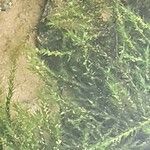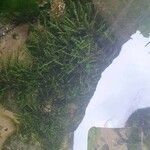Perennial, aquatic herb, submerged, dioecious, with a perennial rhizome. Stems ± 3 mm in diam., terete. Leaves alternate, 6.5-30.0 x 2-5 mm, spreading, recurved. Male inflorescence axillary; spathe cup-shaped, containing many pedicellate male flowers, buds become detached and rise to surface (because of an enclosed air bubble) where they expand and recurve suddenly to form a bell-shaped, floating flower; perianth 3 + 3; filaments ultimately parallel to water surface with anthers at right angles to them; staminodes 3, longer than stamens, joined at top (acting as a sail). Female inflorescence axillary; spathe valves fused, containing 1-3 flowers; flowers remain attached, mature flowers float on the water surface, styles 3.
Submerged, dioecious, perennial, aquatic, usually attached but able to survive submerged and free-floating, rhizomatous; stems branched, to c. 5 m long. Leaves alternate, widely spaced below, closely spaced above, recurved, 0.5–2 cm long, 2–3 mm wide; margins minutely toothed. Male flowers (not yet recorded in Australia) with spathe 3–5 mm long; outer perianth segments 1.25 mm long, the inner 1 mm long; stamens 1.25 mm long; staminodes c. 2 mm long. Female flowers in spathe usually 3.5 (–5.5) mm long; perianth segments 1–2 mm long, pinkish, and outer whorl slightly wider than inner; hypanthium thread-like, with length varying according to water depth; staminodes 0.4 mm long; stigmas purple. Seeds c. 2 mm long.
Vigorous aquatic perennial. Stems very fragile, to 1 m long, ± 3 mm diam., branched. Leaves distant below, crowded above, alternate, recurved, stiff, opaque, acute to acuminate, c. 16 × 2 mm, margins minutely toothed. All N.Z. collections have been from female plants. Flowers 1 per spathe in axils of upper leaves; female flowers with filamentous perianth-tube c. 0.25 mm diam., to 6 cm long; perianth-segments pink, long, transparent, with obvious midnerve; staminodia 3, < styles, transparent, white, toothed at tip; styles 3, 1 mm long, bifid, red-purple.
Aquatic herb, submerged. Stems robust, ± 3 mm in diameter. Leaves with blade thick, 2-5 mm wide, margins opaque and with short, blunt, ascending teeth. Flowers: male inflorescence with up to 50 flower buds; female inflorescence with perianth pink, up to 150 mm long; Nov.-Apr.
Aquatic herb, submerged. Leaves thick, opaque, 2-3 mm broad, cells small, somewhat papillose-rhomboid. Teeth of leaves minute, blunt, ascending.



